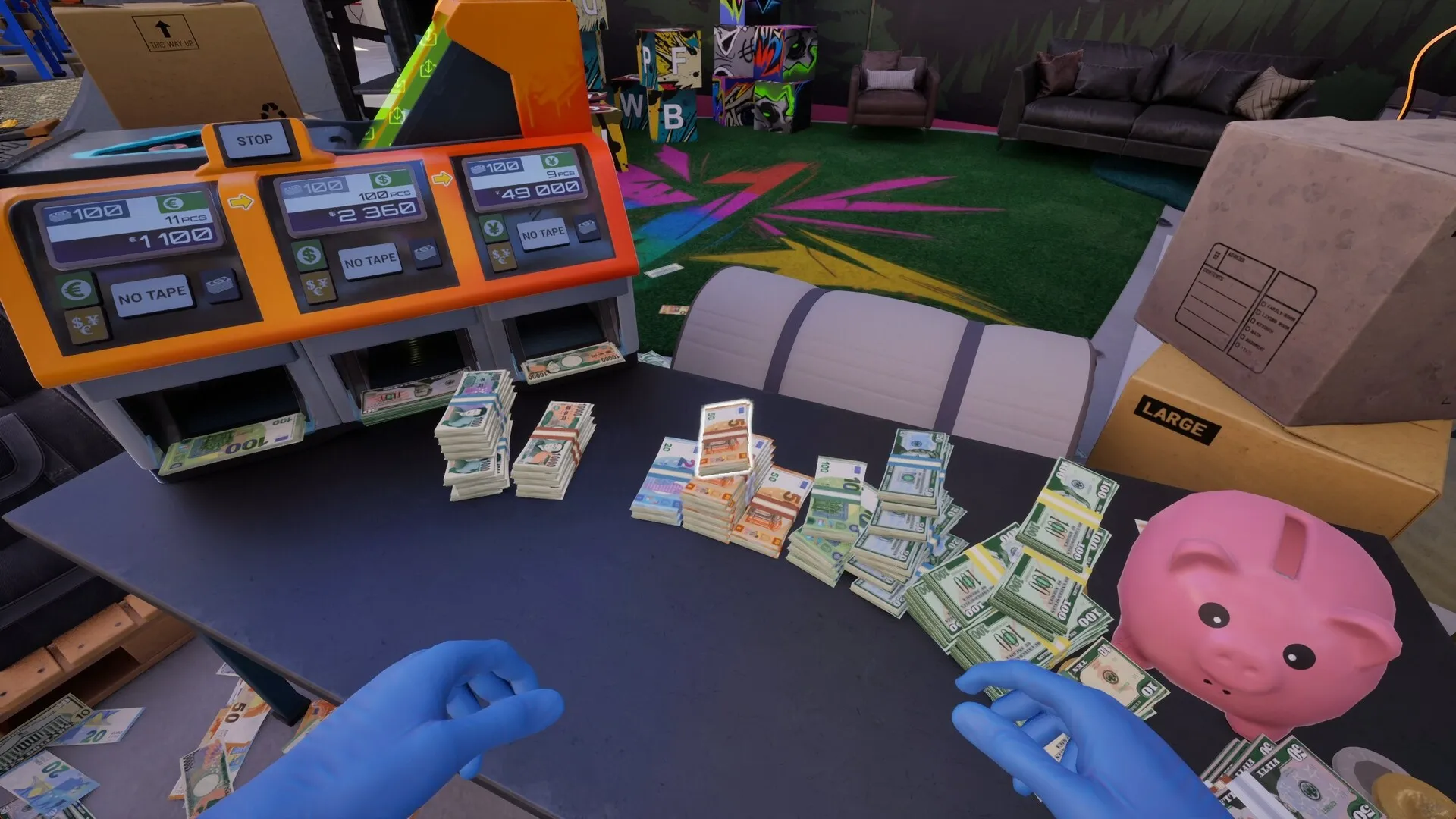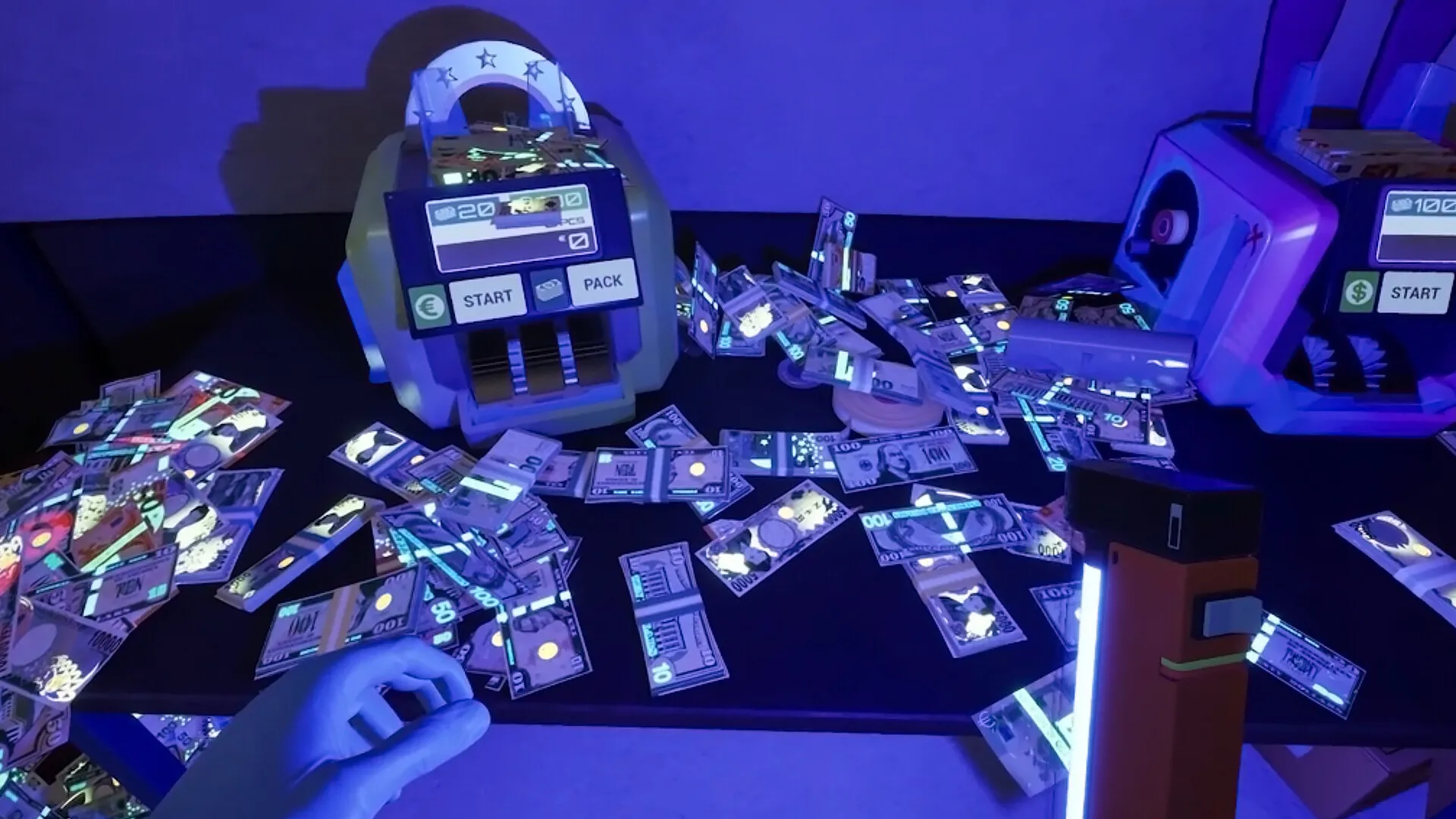Cash Cleaner Simulator drops you into a cramped, dimly lit room with no memory of how you arrived. Your only link to the outside world is a cryptic phone call from an unseen handler, tasking you with laundering cash for shadowy clients. Bills rain from a hole in the ceiling, and you must unpack, sort, wash, count, and package them to meet each order’s exact specifications.
The absurd premise blends slapstick physics—watching wads of bills scatter—with a casual rhythm that invites experimentation. From the moment you grab your first stack of notes, the game balances the joy of tactile routine against the puzzle of juggling customer demands. You’ll quickly learn that every denomination, marking or suspicious dye pack carries its own rules, and your freedom hinges on depositing one million dollars into a giant glass piggy bank overhead.
This introduction sets the tone for a lighthearted sim that values steady progress as much as unexpected quirks, teasing both zen-like repetition and the faint thrill of uncovering new tools and secrets in a quirky indie package.
Mechanics in Motion
You cycle through a clear sequence: accept a job on your phone, gather cash from random drop points, sort by value or markings, use machines or washing cycles, then bundle and send on a conveyor belt. Early tasks focus on simple backpack deliveries with single denominations, while later orders demand mixed currencies, precision counting of dyed or fake notes, and careful handling of security-locked bags.
Starter tools include manual pick-up (hold “F”) and a basic inventory accessed by “TAB.” As you earn crypto payments, you unlock a cash counter that rattles and dings with satisfying accuracy, a blacklight for spotting marked bills, a scanner app that highlights mission-related items, plus shelves, trolleys and an automated sorting machine. Each upgrade streamlines a specific bottleneck—counters speed up counting, blacklights remove guesswork on markings, and the scanner cuts downtime spent hunting hidden stacks.
The game offers a brief tutorial covering movement, grabbing, and the first job, but key features like the scanner go undisclosed, encouraging players to explore menus and experiment. Controls remain mouse/keyboard only—no controller support—so menu navigation can feel clumsy under pressure.
Early missions ease you in with small piles and forgiving timeframes, yet by mid-game the volume spikes and bills fly across the room, turning tidy tasks into chaotic ballets. This shift challenges attention and can feel repetitive when new mechanics arrive slowly, but it also rewards planning and thoughtful tool placement as complexity grows.
Story Signals and Voice Lines
Your narrative unfolds through phone calls and text logs from two main voices: Betty Oops and The Collector. Betty opens with a friendly tone that gradually cracks into outright hostility, hinting at hidden motives.
The Collector remains calm and businesslike, offering context on each assignment without revealing why you’re trapped. Their contrasting personalities inject tension into routine work orders, but side clients—drawn from dark-web caricatures—tend to feel interchangeable and drop out once their job ends.
Mystery arises from fragmented clues: scattered notes about who you are, why you owe a million dollars, and what happens if you fail. The ever-looming glass piggy bank forces a constant reminder of stakes: is this punishment, a twisted game, or both? Mission descriptions carry dry humor—referencing dye packs or illicit ink stains—but rarely slip into sincere warmth.
Small touches, like a client who cracks jokes about counterfeit bills or another who fusses over bundle weight, could add emotional color if expanded. As written, each message sustains curiosity without delivering a larger arc, leaving the core plot feeling secondary to the mechanical loop.
Aural and Visual Audit
Visually, the game mixes gritty grime with playful cartoony elements. Your workspace sports graffiti-splashed walls, industrial washing machines and scattered dollar bills, all rendered with crisp texture on each note. Animations range from satisfying bill tosses to occasional clipping or physics glitches—watching currency hover in mid-air can break immersion, though it also highlights the unpolished indie charm.
Audio design anchors the loop: radios purchased via crypto stream varied tracks that set a relaxed or upbeat mood, and default tunes pump through a bedside alarm clock. Cash-counter machines rattle realistically, complete with a “ding” on each batch count. Conveyor belts hum, and washing cycles spin with authentic mechanical whirs. Voice messages deliver clear lines, though an AI-art disclaimer on some phone icons feels out of place.
Performance holds steady under light loads, but frame dips occur when piles of cash and boxes fill the room. A reported bug locks a specific box that crashes the game if reused, forcing players to abandon it or restart—an issue that undermines trust in save stability. Load times remain brief and quick autosaves minimize lost progress.
Players can invest roughly 15–20 hours reaching the million-dollar goal and unlocking every tool. Side missions and achievements extend play, yet each job leverages the same core actions with little twist. Introducing optional challenges—like sorting under a timer or zero-upgrade runs—could reinvigorate sessions. For now, the ritual of organizing cash offers quiet satisfaction, even as its repetition tests patience in longer marathons.
The Review
Cash Cleaner Simulator
Cash Cleaner Simulator delivers a surprisingly engaging loop of sorting, counting and washing cash, with satisfying tools and quirky physics that invite short bursts of play. Its minimalist story and repetitive late-game routine, along with occasional technical hiccups, keep it from feeling truly fresh over long sessions.
PROS
- Satisfying tactile loop of sorting and counting cash
- Meaningful upgrades that streamline tasks
- Quirky physics add playful unpredictability
- Clear, accessible controls and interface
- Atmospheric audio that enhances immersion
CONS
- Repetitive mechanics can feel tedious over time
- Minimal narrative depth beyond core premise
- Occasional frame dips and rare crashes
- Key tools unlocked without clear guidance
- Limited variety in late-game missions

















































